|
Dynamic
interference
colors in thin soap films
Andrew Davidhazy Imaging and Photographic Technology School of Photo Arts and Sciences / RIT Colors that seem to appear almost by magic on the surface of soap bubbles that float away into our surroundings have fascinated and delighted us for generations. The cause for those color has been a matter of much research and study. It is well understood that they are caused by the interference of incident and reflected light rays from the front and rear surface of the thin layer of soap making up the bubble. There are many industrial and technical applications for the knowledge related to thin films and the colors that we see on them, but in this case we are mainly concerned with photographing them with the purpose of visualizing the color patterns in a dynamic and effective manner for esthetic rather than scientific purposes. Instead of photographing spherical bubbles launched into the air by propelling them from a bubble blowing hoop, the emphasis here will be to photograph a thin layer or film of soap created by dipping a frame into a soapy solution. Upon withdrawal of the hoop from the soapy solution a relatively taut thin film of soapy liquid will temporarily establish itself across the open area of the frame. The color effects are a result of light reflecting off the soap surface so attempts to photograph them by transillumination are not possible. Further, a point source of light is not suitable either as then only a small spot on the film will be affected. To perceive the full spectrum of color over the full surface of the film it needs to be lit up by a broad, diffuse, source generally located close to the optical axis of the camera. The physical effects associated with these soap films held in a frame are sometimes quite dynamic and therefore usually a short exposure time is required to achieve sharp results. I have found that electronic flashes bounced into a sheet of stiff white paper through which the camera lens is poked and aimed at the region of interest is a good lighting solution. The flow patterns on these sheets of soapy liquid are usually quite small. To reproduce them at a respectable size some kind of close-up photography is necessary. This is achieved either with a macro lens or extension tubes. The macro lens is most convenient but I have used both methods with success. To use extension tubes for life size photography one simply inserts as much of an extension tube as the focal length of the lens one will be using. This ensures 1:1 reproduction at the image or sensor plane of the camera as long as the lens' focusing scale remains set to infinity. 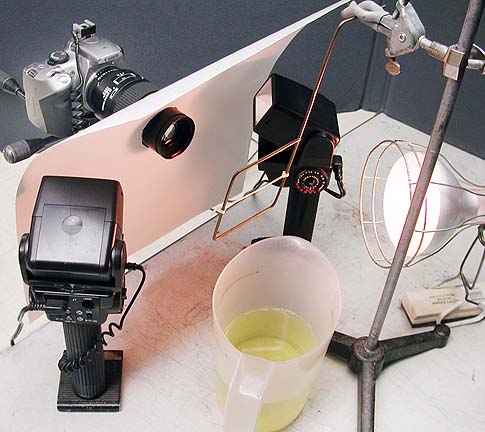 For lighting I used two
Sunpack 522
flash units
with one of them
slaved to the other. They were lined up so that there would be little
in terms of spill into the camera lens even though they are facing each
other
on the same side of the reflecting sheet of white paper. Operating
them at 1/8 or 1/16 th power with the camera set to a sensor speed of
100, I was able to keep the lens aperture at about f/16. This
provided badly needed depth of field since the soap film was slightly
angled to the sensor plane within the camera. For lighting I used two
Sunpack 522
flash units
with one of them
slaved to the other. They were lined up so that there would be little
in terms of spill into the camera lens even though they are facing each
other
on the same side of the reflecting sheet of white paper. Operating
them at 1/8 or 1/16 th power with the camera set to a sensor speed of
100, I was able to keep the lens aperture at about f/16. This
provided badly needed depth of field since the soap film was slightly
angled to the sensor plane within the camera.This slight angling of the film is necessary to avoid the reflection of the camera lens within the image of the film in the final photograph. Operating in the life-size range of magnifications brings with it extremely reduced depth of field so the capability of operating at a small aperture is almost a necessity to ensure photographs that are sharp from top to bottom. On the other hand, if you happen to have access to a tilting lens then you can take advantage of the Schimpflug condition and truly extend apparent depth of field to encompass large distances. I did improvise just such a lens and used it to advantage later on in the process. As you can see from the photograph of the set-up above the wire frame was suspended from a clamp in such a manner that the soapy solution in the container could be raised and the frame dunked into the liquid. This ensures that the soap film will be in the same place from photograph to photograph which is not guaranteed if one dips the frame in the liquid to renew the soap film after it eventually breaks. It is a lot more difficult to reposition the frame in its original position than it is to simply raise the soap water contained and rewet the frame. 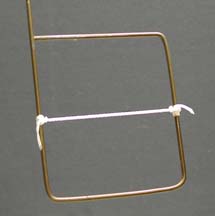 The soap
liquid can be made up in any number of different
"formulations". From simply slightly diluting standard dishwashing
soap, to diluting it a little (or a lot) with water, adding a small
amount of glycerin may be helpful in extending the lifetime of any
given film. Experimentation is encouraged! The soap
liquid can be made up in any number of different
"formulations". From simply slightly diluting standard dishwashing
soap, to diluting it a little (or a lot) with water, adding a small
amount of glycerin may be helpful in extending the lifetime of any
given film. Experimentation is encouraged!I found that having the frame made of porous, fluffy, material seems to also promote longevity of the soap films. I stretched a length of cotton string from one side of the frame to the other to form the top of the film layer. This seemed to provide the film with some extra soap solution over time allowing the film to remain in place for a longer time than if I had been using the bare metal wire frame. 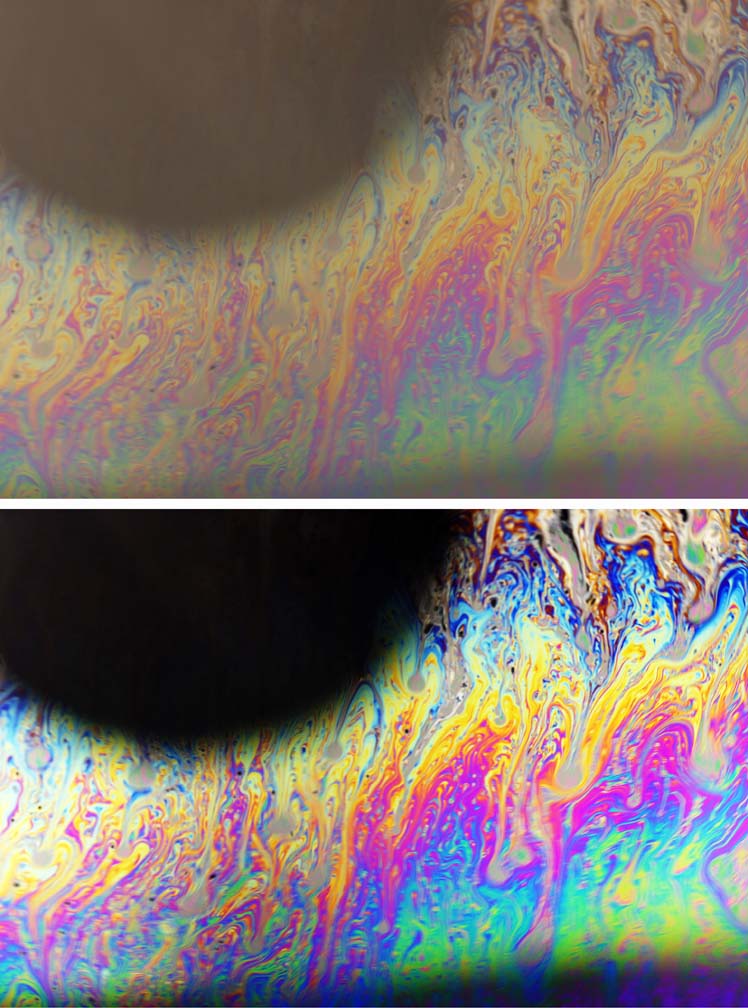 The
tungsten light is not an absolute necessity
but it lights up the
reflecting white paper providing an opportunity to previsualize in the
camera's viewfinder the
color patters that appear on the film over time and makes the decision
making process as to when to make the photographs more controlled. Of
course you will probably be making more than one exposure for each
replenishment of the frame with soapy liquid. The
tungsten light is not an absolute necessity
but it lights up the
reflecting white paper providing an opportunity to previsualize in the
camera's viewfinder the
color patters that appear on the film over time and makes the decision
making process as to when to make the photographs more controlled. Of
course you will probably be making more than one exposure for each
replenishment of the frame with soapy liquid.At the right is one of the earliest photographs I made with the above set-up. It obviously suffers from several negative quality factors, low saturation, lack of overall sharpness and the inclusion of the black spot being some of them. But these less-than-acceptable images did point the way for more exciting things to come! As you can see the colors as they are recorded by the camera (top) are not as vivid as what you see reproduced in the lower version and the rest of the photographs on this page. These photographs have been adjusted with levels and tweaked with curves using commonly used image processing software. With improvement of technique, particularly on the matter of careful and accurate focusing and the angling of the film to remove the black central spot caused by reflection of the camera lens in the soap film, the image quality issue started to improve and I made the following photographs. 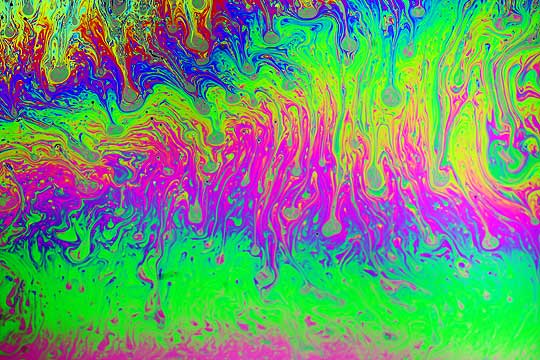 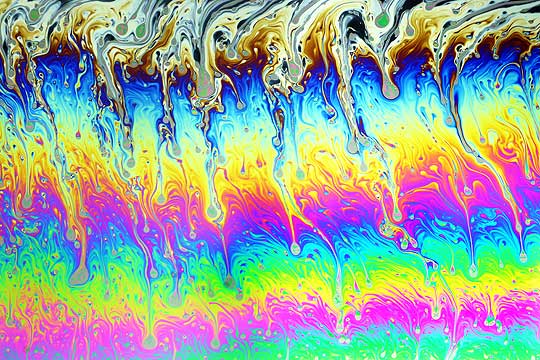 One tends to get carried away making these colorful photographs and shooting hundreds of images is not uncommon. Often the beauty inherent in the recorded images does not make itself evident until the images have been processed. 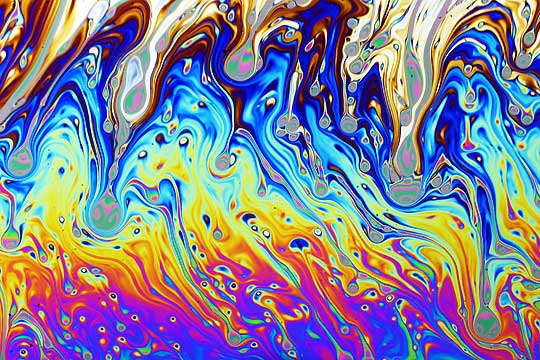 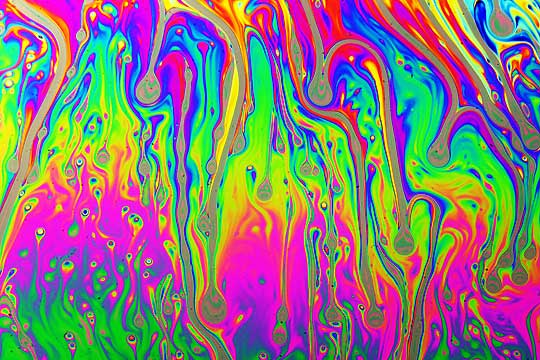 I found the period in
the lifetime of a soap film to be most interesting just about at the
time
the film is about to break. With time the film gets thinner and thinner
and the colors become more saturated until actually in certain
locations
the film becomes black or transparent. That is a signal the the film
has become so thin that it is about to vanish.
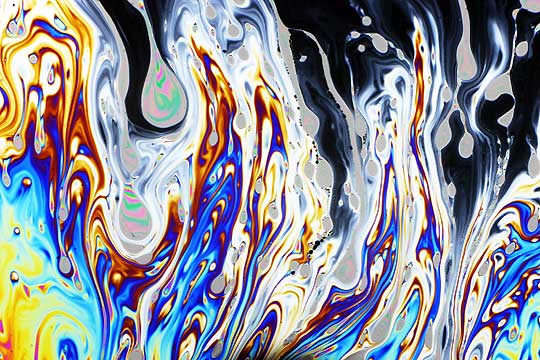 Making photographs of thin soapy films can be a most challenging but rewarding activity. The patterns and colors are constantly changing. It is essentially an unpredictable form that each image takes and this is another example of where ruthless editing of flawed images must be exercised because if one does not do this the danger of accumulating hundreds or thousands of these photographs is a distinct possibility. If you found this article
of interest and would like to communicate with me about it feel free to
send me email at
Andrew Davidhazy, andpph@rit.edu |